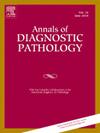p63 immunohistochemical expression in tumor cells of high-grade invasive breast carcinomas on core biopsy: a potential diagnostic pitfall
IF 1.4
4区 医学
Q3 PATHOLOGY
引用次数: 0
Abstract
In breast pathology, p63 is a highly specific myoepithelial marker, crucial for distinguishing in situ from invasive lesions. Its expression is characteristically absent in the neoplastic cells of invasive carcinoma. However, in our diagnostic experience focal p63 expression in neoplastic cells of some high-grade breast tumors has been observed. This study aimed to describe the expression pattern of p63 in high-grade versus low and intermediate-grade invasive breast carcinomas. We performed a retrospective immunohistochemical analysis for p63 on a cohort of 60 breast core biopsies. The cases included 20 Grade 3 (G3), 20 Grade 2 (G2) and 20 Grade 1 (G1) invasive breast carcinomas, graded according the Nottingham grading system. Nuclear p63 expression in neoplastic cells was assessed and described. Positive p63 staining in neoplastic cells was identified in 16 out of 20 (80 %) high-grade invasive carcinomas. The staining pattern was typically focal and moderate in intensity. Conversely, all but one case of invasive breast carcinoma G2 showed absolute negativity for p63. All cases of low-grade invasive carcinoma also showed clear negativity for p63. A clear association between p63 expression in neoplastic cells and G3 grading was observed.
Our findings suggest that p63 expression can be a feature of high-grade invasive breast carcinoma. Although this findings represents a potential diagnostic pitfall, especially on small core biopsy samples, the awareness of this possibility can also allow p63 to serve as a helpful ancillary clue for identifying high-grade disease.
P63在高级别浸润性乳腺癌核心活检肿瘤细胞中的免疫组织化学表达:一个潜在的诊断缺陷
在乳腺病理学中,p63是一个高度特异性的肌上皮标志物,对于区分原位病变和侵袭性病变至关重要。它在侵袭性癌的肿瘤细胞中不表达。然而,根据我们的诊断经验,在一些高级别乳腺肿瘤的肿瘤细胞中观察到局灶性p63的表达。本研究旨在描述p63在高级别、低级别和中级别浸润性乳腺癌中的表达模式。我们对60例乳腺核心活检进行了p63的回顾性免疫组织化学分析。3级(G3) 20例,2级(G2) 20例,1级(G1) 20例,按照Nottingham分级系统进行分级。评估和描述肿瘤细胞中核p63的表达。20例(80%)高级别浸润性癌中有16例肿瘤细胞p63染色阳性。典型的灶性和中等强度的染色模式。相反,除一例浸润性乳腺癌G2外,其余病例p63均为绝对阴性。所有低级别浸润性癌均显示p63明显阴性。p63在肿瘤细胞中的表达与G3分级有明显的相关性。我们的研究结果表明p63表达可能是高级别浸润性乳腺癌的一个特征。尽管这一发现代表了一个潜在的诊断缺陷,特别是在小的核心活检样本中,但对这种可能性的认识也可以使p63作为识别高级别疾病的有用辅助线索。
本文章由计算机程序翻译,如有差异,请以英文原文为准。
求助全文
约1分钟内获得全文
求助全文
来源期刊
CiteScore
3.90
自引率
5.00%
发文量
149
审稿时长
26 days
期刊介绍:
A peer-reviewed journal devoted to the publication of articles dealing with traditional morphologic studies using standard diagnostic techniques and stressing clinicopathological correlations and scientific observation of relevance to the daily practice of pathology. Special features include pathologic-radiologic correlations and pathologic-cytologic correlations.

 求助内容:
求助内容: 应助结果提醒方式:
应助结果提醒方式:


